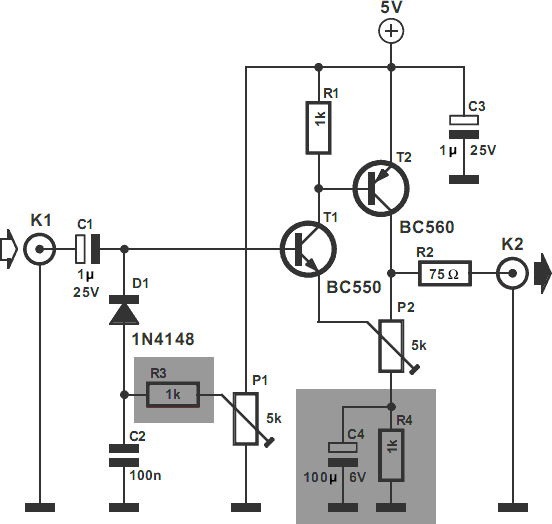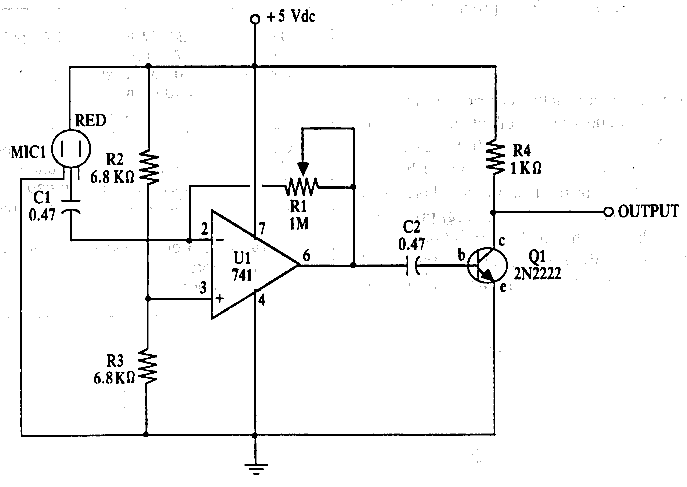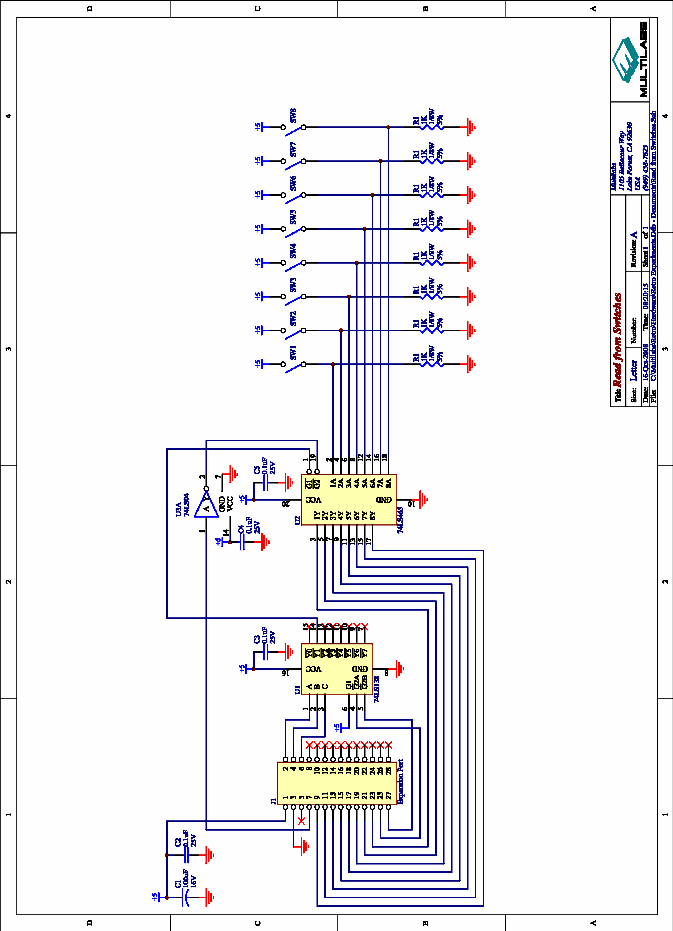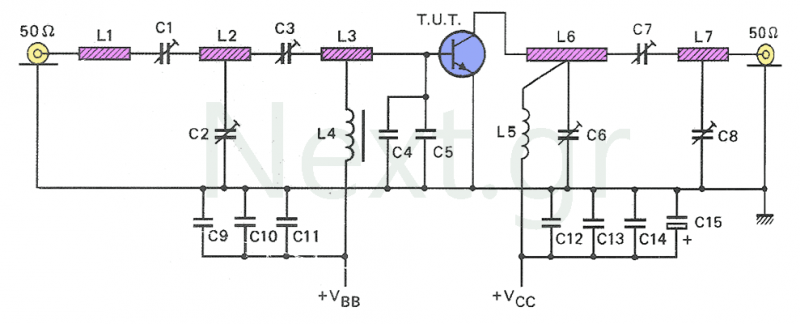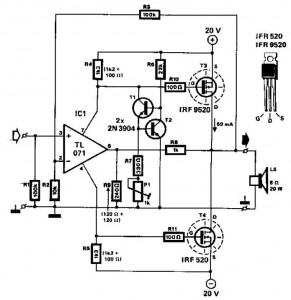
10 w amplifier using tda2003
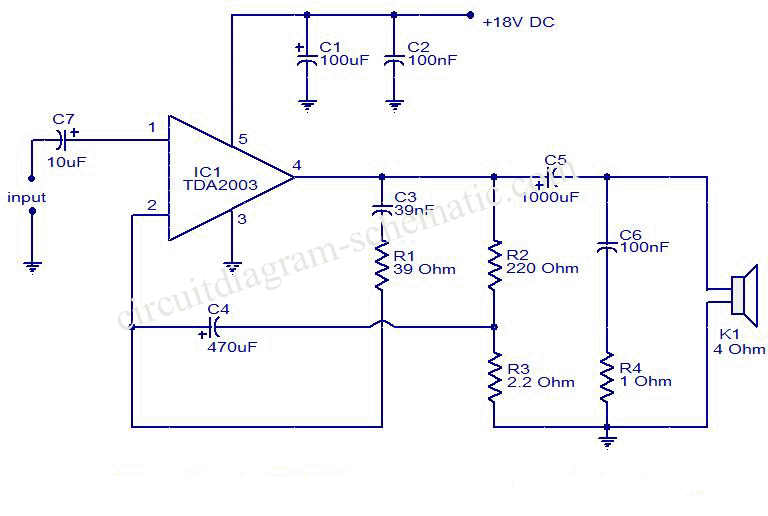
This is a circuit diagram of an audio amplifier circuit featuring a 10W power amplifier using the TDA2003 integrated circuit from SGS Thomson. The IC is capable of delivering 10W into a 4-ohm load at a supply voltage of 18V DC. It can also operate at 12V, making it suitable for car audio systems. Notable features of the TDA2003 include short-circuit protection among all pins, thermal overload protection, and low harmonic distortion. The circuit is designed based on the manufacturer's datasheet and has proven to be effective. The schematic includes a C7 capacitor for DC input decoupling. Resistors R2 and R3 are utilized to adjust the gain, while R1 determines the overall amplification. Capacitor C3 is employed to cut off high-frequency signals. Components C6 and R4 enhance stability at high frequencies. Capacitor C5 is used to couple the output to the speakers. This circuit diagram can be implemented for a car audio power amplifier or in a small room setup.
The TDA2003 integrated circuit is a popular choice for audio amplification applications due to its robust design and reliability. It features built-in protections that enhance its durability in various operating conditions. The circuit's configuration allows for effective amplification while minimizing distortion, which is critical for high-quality audio output.
The power supply for this circuit should be capable of providing a stable voltage of 12V to 18V, with a current rating sufficient to support the load requirements. The use of capacitors C7 and C5 is essential for filtering and stabilizing the power supply, ensuring that the amplifier operates efficiently without introducing noise into the audio signal.
In the gain adjustment stage, R2 and R3 can be selected to achieve the desired amplification level. The resistor R1 plays a crucial role in setting the overall gain of the amplifier, and its value can be calculated based on the desired output power and input signal level. The design also incorporates C3, which serves as a high-pass filter, effectively blocking low-frequency signals that may not be needed in certain applications.
For high-frequency stability, C6 and R4 are strategically placed to dampen any oscillations that may occur during operation, ensuring that the amplifier remains stable even under varying load conditions. This feature is particularly important in car audio systems where environmental factors can influence performance.
Overall, this circuit design is versatile and can be tailored to suit different audio applications, making it an excellent choice for both amateur and professional audio enthusiasts.This is a circuit diagram of amplifier circuit, these circuits have a 10W audio power amplifier using TDA2003 IC from SGS Thomson popular. The IC can easily provide 10W into 4 Ohms load at 18V DC supply voltage. IC can also be operated from 12V and that makes it applicable in a car audio system. Useful features include TDA2003 short circuit protec tion between all pins, thermal overload protection, low harmonic distortion, low distortion. The circuit given here is designed according to the datasheet from the manufacturer and found to be working well. The following is a schematic drawing: C7 capacitor DC input work decoupling. R2 and R3 are used to adjust the gain of R1 determines amplifier. C3 and cut off the top frequency. C6 and R4, and is intended to increase the stability of high frequency. The capacitor C5 couples the output to the speakers. You can try this circuit diagram for your car audio power amplifier or to a small room. 🔗 External reference
The TDA2003 integrated circuit is a popular choice for audio amplification applications due to its robust design and reliability. It features built-in protections that enhance its durability in various operating conditions. The circuit's configuration allows for effective amplification while minimizing distortion, which is critical for high-quality audio output.
The power supply for this circuit should be capable of providing a stable voltage of 12V to 18V, with a current rating sufficient to support the load requirements. The use of capacitors C7 and C5 is essential for filtering and stabilizing the power supply, ensuring that the amplifier operates efficiently without introducing noise into the audio signal.
In the gain adjustment stage, R2 and R3 can be selected to achieve the desired amplification level. The resistor R1 plays a crucial role in setting the overall gain of the amplifier, and its value can be calculated based on the desired output power and input signal level. The design also incorporates C3, which serves as a high-pass filter, effectively blocking low-frequency signals that may not be needed in certain applications.
For high-frequency stability, C6 and R4 are strategically placed to dampen any oscillations that may occur during operation, ensuring that the amplifier remains stable even under varying load conditions. This feature is particularly important in car audio systems where environmental factors can influence performance.
Overall, this circuit design is versatile and can be tailored to suit different audio applications, making it an excellent choice for both amateur and professional audio enthusiasts.This is a circuit diagram of amplifier circuit, these circuits have a 10W audio power amplifier using TDA2003 IC from SGS Thomson popular. The IC can easily provide 10W into 4 Ohms load at 18V DC supply voltage. IC can also be operated from 12V and that makes it applicable in a car audio system. Useful features include TDA2003 short circuit protec tion between all pins, thermal overload protection, low harmonic distortion, low distortion. The circuit given here is designed according to the datasheet from the manufacturer and found to be working well. The following is a schematic drawing: C7 capacitor DC input work decoupling. R2 and R3 are used to adjust the gain of R1 determines amplifier. C3 and cut off the top frequency. C6 and R4, and is intended to increase the stability of high frequency. The capacitor C5 couples the output to the speakers. You can try this circuit diagram for your car audio power amplifier or to a small room. 🔗 External reference
